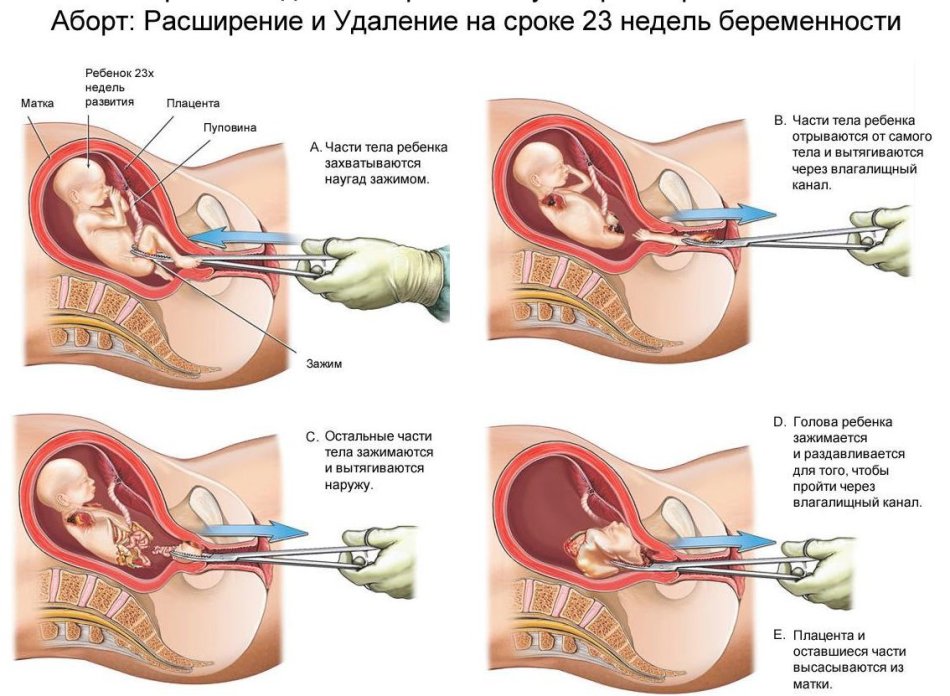- In life, there are situations when the desired sex ends with an unwanted pregnancy. The woman has a choice - leave a child or not. For certain reasons, the scales bowl are sometimes inclined in favor of the child. I suggest you get acquainted with the methods of termination of pregnancy and the consequences of such a step in this article.
Content
- Medication or surgical termination of pregnancy?
- Surgical methods of termination of pregnancy
- Surgical termination of pregnancy in the early stages
- Surgical termination of pregnancy in the late stages
- How is surgical termination of pregnancy?
- Is pregnancy possible after surgical termination of pregnancy?
- Discharge after surgical termination of pregnancy
- Complications and consequences of surgical termination of pregnancy
- Monthly after surgical termination of pregnancy
- Surgical termination of pregnancy: tips and reviews
- Breeding pregnancy, video
- Sometimes it turns out that the second half is categorically not ready for the birth of a baby. In many cases, pregnancy is even contraindicated for a woman for medical reasons
- The decision to terminate the pregnancy is not easy, and it is worth consciously weighing everything for and against such a choice. If you still decide to abortion, you should not put off the procedure, hesitating, because termination of pregnancy with the least risk is possible only until a certain period. The longer you pull, the more complications can arise
Medication or surgical termination of pregnancy?
The method of termination of pregnancy depends on many factors: the state of health of the pregnant woman, the gestational age, the solvency of the patient. Before making a choice, you should go through a number of necessary procedures:
- Inspection of the gynecologist
- Determination of blood type
- Analyzes for STD
- Analysis for HIV
- Checking for hepatitis
- Ultrasound procedure
- HCG-analysis
- Smear on the flora
When all the necessary tests are handed over, you can start discussing the method of termination of pregnancy. There are two such methods:
Medication abortion
- It is carried out exclusively in the early stages (up to 6-7 weeks) and does not imply any physical intervention in the uterus. It is considered the most gentle way of abortion with a minimum risk of complications. This type of abortion poses a minimum threat of hormonal stress for the body
- Medication abortion is convenient in that you do not have to go to the hospital. At the reception, the doctor will give you a tablet that needs to be taken in his presence, and another drug for receiving a house. After that there is a miscarriage
- Of course, not everything is so simple. You will still have to be under the supervision of a doctor, take restoring drugs and after 10-14 days to again undergo an examination
- You can not name a medication of pregnancy absolutely safe. It can lead to bleeding or continuation of pregnancy
- Moreover, taking medications leads to the development of fetal pathologies, so in this case you will have to resort to surgical intervention. You can not independently conduct drug abortion
Preparations with which the termination of pregnancy in the pharmacy is provoked not to purchase, and buying over the Internet can cause irreparable damage to your body.
Important: drug abortion is ineffective with an ectopic pregnancy
Surgical abortion
- It implies an intervention in the uterus, which is carried out before a period of 12 weeks. Is an operation with all the ensuing consequences
- During surgical termination of pregnancy, the cervix is \u200b\u200bexpanded and a fetal egg is tugs out of it. This type of intervention in a woman’s reproductive system can lead to the inability to bear the fetus or infertility, and the operation is accompanied by impressive blood loss
- When choosing a surgical abortion, prefer a doctor with good recommendations whose qualification will provide you with a quality operation. There are frequent cases when parts of the fetus remain in the uterus, which leads to inflammatory processes and the need for repeated operations

Surgical methods of termination of pregnancy
Surgical methods involve the removal of a fetal egg from the uterus through surgery. There are several types of such an intervention depending on the gestational age and indications for its interruption:
- Vacuum or mini-abortion
- Instrumental removal
- C-section

Surgical termination of pregnancy in the early stages
In the early stages, 2 types of termination of pregnancy are possible surgically:
- Up to 6-8 weeks-vacuum abortion
- Up to 12 weeks - instrumental curettage
Surgical termination of pregnancy in the late stages
Late is an abortion after a period of 12 weeks. Opinions about the borders of the abortion of doctors are divided: some argue that the maximum term for termination of pregnancy is 20 weeks, while others believe that 24.
The need to carry out an abortion in the later stages is considered by a commission that consists of a doctor, lawyer, social worker
- In the late stages (no later than 15 weeks) it is likely to terminate the pregnancy through simultaneous removal of the fetal egg From the uterus. In fact, it is a variety of instrumental curettage, but threatens in large complications due to the late pregnancy. This method is used only when immediate purification of the uterus is required due to the failure of another surgical intervention.
This method is fraught with prolonged abortion, uterine injury, and abundant bleeding - Expansion of the cervix
After using the expander, the musco forceps are used with attached cargo. This type of abortion can last a day and carries many risks for the health and fertility of the patient, so it is extremely rare - C-section In the late stages, it is safer. It is practically not carried out exclusively at the request of the patient, medical or social indications are required to conduct the operation.
So, medical indications include: the threat of a woman’s life associated with pregnancy, or vices of the physical or mental development of the fetus - For social reasons, abortion through cesarean section in the later stages is carried out much less often. For example, the prerequisites for termination of pregnancy can serve: pregnancy due to rape, loss of the breadwinner, stay of the expectant mother in places not so remote, deprivation of parental rights

How is surgical termination of pregnancy?
Surgical methods of termination of pregnancy are combined by the use of anesthesia and physical intervention in the uterus. I suggest you familiarize yourself with the technology of surgical abortion:
Vacuum abortion (mini-abortion, vacuum aspiration)
- In general, the operation lasts 5-10 minutes.
The beginning of the operation depends on whether the woman gave birth to earlier. The cervix is \u200b\u200bexpanded not to give birth and local anesthesia is administered - For previously giving birth, the operation begins directly with anesthesia. Next, a pipe from the pump is placed in the uterus. Then the pump turns on, creating a negative pressure in the uterus of about 0.5 atmospheres, and the fetal egg, peeling off, goes through the tube
- This type of surgical termination of pregnancy has a small risk of complications, during it the uterine mucosa practically does not suffer from damage
Important: vacuum abortion does not give a 100% guarantee and is not recommended for an ectopic pregnancy.
- Instrumental curettage
The cervix is \u200b\u200bopened with an extensor, after which a fruit egg is removed by a loop. Then the surgeons fully capture the uterine cavity from the remnants of the embryo. Surgery is underway under general anesthesia and is accompanied by significant blood loss - C-section
It is carried out exclusively in the late stages according to serious medical indications, such as the need to urgently extract the fruit from the uterus with a threat to the life of a pregnant woman or contraindications for artificial childbirth (as a kind of drug abortion).
Doctors cut the front wall of the abdominal cavity, make an incision in the uterus and manually take out the fruit. After that, the uterine cavity is cleaned.
In some cases, vaginal cesarean section can be used. During this operation, the bottom of the uterus is cut, and the fetus goes through the vagina

Is pregnancy possible after surgical termination of pregnancy?
- All surgical methods of termination of pregnancy are united by interference in the uterus, which threatens it with damage. This can lead to the inability to bear the child in the future, complications of the course of future pregnancy and childbirth
- There are frequent cases when surgical abortion leads to a violation of reproductive function, or even to infertility
- According to statistics, the threat of miscarriage after surgical termination of pregnancy reaches 25%, and 50% of cases of infertility are its consequences
- After the operation, it is extremely seriously related to contraceptive issues until the cycle is restored, and pregnancy is not recommended earlier than 6-8 months after

Discharge after surgical termination of pregnancy
Selection after surgical abortion lasts 7-10 days and should not cause concerns. Consult a doctor if you notice:
- The yellowish color of the discharge
- Sharp, unpleasant odor
- Abundance
- The presence of impurities or the presence of clots
Complications and consequences of surgical termination of pregnancy
The larger the gestational age, which has been abortion, the more complications and irreparable harm to health, it can bring. Among a number of the consequences of late abortion, one can distinguish:
- Gap of the cervix
- Long -term abundant bleeding
- Polyps
- Inflammatory processes
- The remains of the fetus in the uterus, which leads to infection
Moreover, later the abortion threatens psychological injuries up to severe depression, because the fetal movements can be felt already at a period of 16 weeks, and some types of abortion can lead to the extraction of a living fruit from the uterus, which, due to its non-vain will die in the torment.
The consequences of cesarean section are with abdominal, that with vaginal access is also not pleased with their diversity:
- Damage to internal organs
- The consequences of anesthesia
- Inflammatory processes
- Spikes
- Problems with the postoperative scar
- Blood poisoning
- The occurrence of hernias
In general, complications after surgical termination of pregnancy can be divided into early and later. Early complications are manifested during the operation and in the postoperative period (anemia, damage to the uterus and internal organs, the remnants of the embryo in the uterine cavity, severe pain syndrome).
Late complications show themselves within a month. Often they are associated with infectious problems and inflammatory processes, which are evidenced by abundant discharge, severe pain in the lower abdomen.

Monthly after surgical termination of pregnancy
Often menstruation occurs about a month after abortion. Then the cycle will fluctuate for a few more months.
The first menstruation may differ from ordinary plentiful or meager discharge, duration. It all depends on the speed of restoration of the body and the quality of the surgical intervention.
Menstruation after termination of pregnancy is exactly the same as before it. If you notice significant deviations of the cycle, an increase in duration after 3-4 months, consult a doctor.
Surgical termination of pregnancy: tips and reviews
- Contact a qualified doctor
- After surgery for 3-4 weeks, let your body recover, refrain from sexual contacts and physical exertion
- Avoid hypothermia
- Monitor body temperature, in case of an increase, consult a doctor
- Adhere to thorough hygiene of the genitals: often wash yourself and change your underwear, you can add a little potassium permanganate to the water to obtain a weak disinfectant solution
- Visit a gynecologist 3 weeks after surgery
The consequences of late abortion are often irreparable, so in the event of an unwanted pregnancy, try to interrupt it in the first weeks. And, of course, think, or maybe you do not need abortion?








